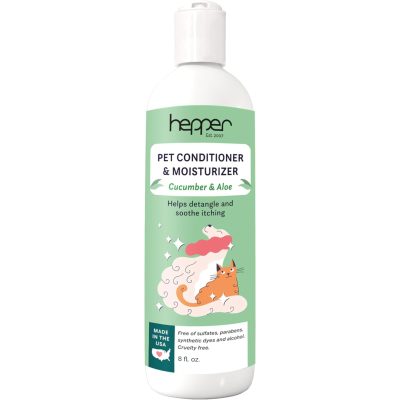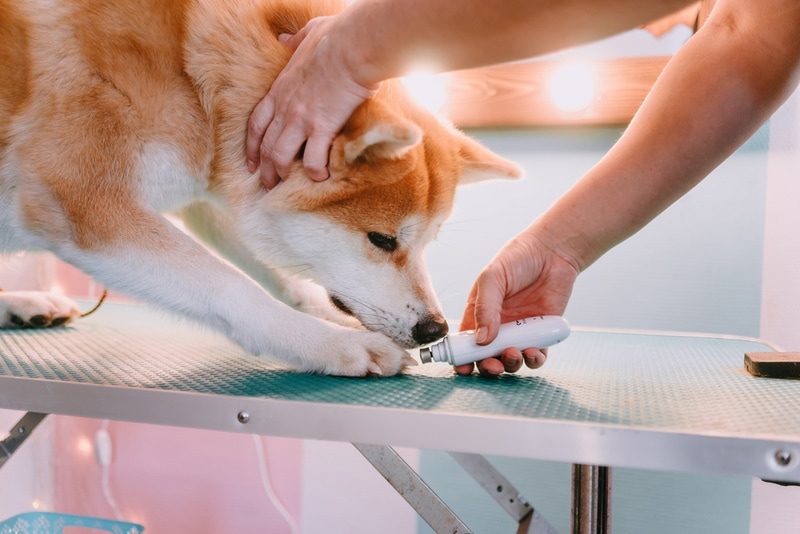In this article
The Akita is a large and powerful dog, with a thick double coat. This combination means the breed can be a challenge to groom. Challenging or not, though, regular grooming is important, and it should consist of brushing and bathing, as well as trimming nails and brushing teeth. While the Akita is an independent dog, it still can not groom itself, so you will need to make grooming a part of your routine to ensure the comfort and good health of your pup.
Below are tips and steps to help make the process smooth and stress-free, for both of you.

The 10 Tips on How to Groom an Akita
1. Start Young
Ideally, you should start grooming a dog when it is a puppy. Not only does this help keep their coat in check, but it gets them used to the whole process. Similarly, if you intend to visit a professional groomer, even if it will only be occasionally, you should start this from a young age, too. It is not always possible to start grooming when your dog is a young puppy. For example, if you adopt an older dog, you may not know whether it was groomed from a young age.
You should start as soon as possible, though, and get both of you accustomed to the whole process.
2. Groom Regularly

There are many aspects to grooming a dog, some of which require daily attention and others that may only need completing every couple of months. With an Akita, you will need to brush at least three or four times a week and ideally daily. Teeth should be brushed at least three times a week, too, and you can bathe your dog every 2 or 3 months while trimming their nails on a similar schedule.
Avoid trying to do everything in one day, though, or it may become too much for both of you to handle.
3. Use Appropriate Shampoo
You should not use human shampoo. Dog hair and human hair have different properties: specifically, they have different pH values, which means they need different care from different products. Using human shampoo on dog hair can dry it out and make the condition worse, rather than better.
Choose a good-quality dog shampoo: ideally one that uses natural ingredients. Ensure you have some in for the next time you bathe your Akita, or you’ll be left with a wet dog and no shampoo.
If you are looking for the perfect, pet-friendly shampoo and conditioner combo, we highly recommend the products by Hepper. With a soothing oatmeal shampoo, free of soaps and other harsh chemicals, and a cucumber and aloe scented conditioner, your pet's skin and coat will be smooth, hydrated, and irritation-free.
| Image | Product | Details | |
|---|---|---|---|

|
Hepper Oatmeal Pet Shampoo |
|
Check Price |

|
Hepper Pet Conditioner |
|
Check Price |
At Dogster, we’ve admired Hepper for many years, and decided to take a controlling ownership interest so that we could benefit from the outstanding products of this cool pet company!
4. Get the Right Brushes
The Akita has a thick double coat. This means it has an undercoat and a topcoat. Both will need attention, and they benefit from having different brushes. An undercoat rake is good for managing that thick undercoat while a slicker brush will get rid of dead top hairs and distribute oils around the whole coat. Brushes do not have to cost a lot of money, but they should be suitable for the job at hand, and you should avoid using human brushes because they are not designed for thick dog hair.
5. Desensitize Them

Grooming a dog the first few times means introducing them to a lot of alien processes: putting a toothbrush in their mouth, soaking them in the bath, cutting nails with sharp clippers, and even toweling and using a hairdryer can cause anxiety and concern in a dog if they aren’t used to it. Before you start grooming, you can get your dog used to some of the tools you will be using.
Let them sniff the nail trimmer and even shadow trim near their feet without touching them. Similarly, let them see and sniff the brushes before you use them.
6. Get Help for Stubborn Akitas
Akitas are strong and very independent dogs, which means it can be a real challenge to bathe one that doesn’t want to be bathed. You should never be aggressive or overly physical, but if yours is a stubborn Akita that objects to getting in the bath, you will need help. If your dog doesn’t like having its nails trimmed, you’re going to need help. If it doesn’t like being brushed, someone will need to help you.
Get somebody to help you, even if it is only passing you everything you need when you need it.
7. Take Your Time
If your dog is against the whole process, or you’re nervous about bathing your Akita, it can be tempting to try and breeze through the process as quickly as possible. However, while taking too long can prolong the stress for all parties, trying to get everything done in a few minutes can prove just as stressful, especially if it means you don’t finish the job properly. It means you will have to do it all again much sooner.
8. Don’t Take Too Long

On the other hand, the longer grooming takes, the more likely your Akita will get bored and restless. A restless Akita is a lot more difficult to brush than a chilled-out Akita. Make sure you get all the important jobs done straight away, and then you can take your time neatening everything up or finishing other grooming tasks. That way, if your dog does get restless, it won’t be too big a deal if you let them walk away.
9. Don’t Bathe Your Akita Too Often
Akitas love to spend time outdoors and they enjoy running around fields and in the muck. They can get dirty. But you shouldn’t be bathing a dog every week. This can damage the coat because it strips natural oils out of the hair and away from the skin, ultimately causing the coat to become dry and brittle. Ideally, you should be bathing your dog every 2 or 3 months. You can always buy wash wipes to spot clean small areas of dirt.
10. Don’t Go Too Far
Trying to bathe and brush your dog before brushing their teeth and trimming their nails can prove too much for any dog so don’t try doing everything all at once. Stick to your regular brushing and tooth brushing schedule and try to fit jobs like nail trimming and bathing in on free days.

Frequently Asked Questions
Do Akitas Need to Go to the Groomers?
You don’t have to take an Akita to professional groomers, although many owners do so for an occasional groom. You could brush your dog daily, bathe them once every few months, and have a professional groomer do a thorough job every 6 months.
Should You Shave an Akita?
There are several reasons why you shouldn’t shave an Akita. The coat protects from the elements, insects, and other potential hazards. Even in summer, when some owners shave their dogs to help combat the hot weather, the undercoat works to trap cool air and therefore provides a layer of protection against the warmth that is removed if you shave your dog. Shaving can also damage the coat and prevent regular shedding which is important to good coat health.
The only time you should shave an Akita is for health reasons or if the coat has become painfully matted.

Summary
The Akita is a big, strong, and somewhat independent dog. It also has a thick double coat to protect against the elements, insects, and other hazards. The coat will benefit from daily brushing, and so will the Akita’s teeth, while nails need to be trimmed when they get too long, typically every 2 or 3 months.
Start grooming as soon as possible and keep up a routine to get you both used to the grooming process and consider having your Akita professionally groomed every 6 months or every year, to get on top of everything.
Featured Image Credit: Ihar Halavach, Shutterstock



















